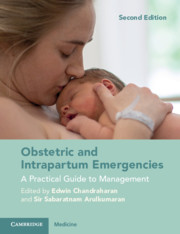Book contents
- Obstetric and Intrapartum Emergencies
- Obstetric and Intrapartum Emergencies
- Copyright page
- Contents
- Contributors
- Preface
- Preface to the First Edition
- Acknowledgements
- Section 1 General Principles
- Section 2 Algorithms for Management of the Top Five ‘Direct Killers’
- Section 3 Intrapartum Emergencies
- Section 4 Postpartum Emergencies
- Chapter 18 Acute Puerperal Uterine Inversion
- Chapter 19 Sudden Postpartum Maternal Collapse
- Chapter 20 Retained Placenta
- Chapter 21 Perineal Trauma
- Section 5 Medical and Surgical Emergencies During Pregnancy
- Section 6 Anaesthetic Emergencies During Pregnancy
- Section 7 Neonatal Emergencies and the Management of Immediate Neonatal Problems
- Section 8 Management of Anticipated and Non-anticipated Emergencies in Pregnancy
- Section 9 Setting-Up Skills and Drills Training in Maternity Services and Reducing Avoidable Harm
- Index
- References
Chapter 18 - Acute Puerperal Uterine Inversion
from Section 4 - Postpartum Emergencies
Published online by Cambridge University Press: 06 May 2021
- Obstetric and Intrapartum Emergencies
- Obstetric and Intrapartum Emergencies
- Copyright page
- Contents
- Contributors
- Preface
- Preface to the First Edition
- Acknowledgements
- Section 1 General Principles
- Section 2 Algorithms for Management of the Top Five ‘Direct Killers’
- Section 3 Intrapartum Emergencies
- Section 4 Postpartum Emergencies
- Chapter 18 Acute Puerperal Uterine Inversion
- Chapter 19 Sudden Postpartum Maternal Collapse
- Chapter 20 Retained Placenta
- Chapter 21 Perineal Trauma
- Section 5 Medical and Surgical Emergencies During Pregnancy
- Section 6 Anaesthetic Emergencies During Pregnancy
- Section 7 Neonatal Emergencies and the Management of Immediate Neonatal Problems
- Section 8 Management of Anticipated and Non-anticipated Emergencies in Pregnancy
- Section 9 Setting-Up Skills and Drills Training in Maternity Services and Reducing Avoidable Harm
- Index
- References
Summary
While 50% of cases of inversion of the uterus have no identifiable risk factors [5], mismanagement of the third stage (applying traction on the umbilical cord before contraction of the uterus and applying fundal pressure) is considered as the prime cause [3].Other recognised predisposing factors include uterine atony, fundal implantation of a morbidly adherent placenta, manual removal of the placenta, precipitate labour, a short umbilical cord, placenta praevia and connective tissue disorders (Marfan syndrome and Ehlers–Danlos syndrome) [3]. It has also been reported to follow sudden increases in intra-abdominal pressure such as coughing or, sneezing before contraction of uterine muscles, delivery of a baby with cord around the neck, giving birth in sitting or erect position, precipitated labour [4] and very rarely during caesarean section [1]. Even though individual risk factors do commonly occur, rarity of the condition indicates that these factors must act in unison to culminate in an inversion of the uterus.
- Type
- Chapter
- Information
- Obstetric and Intrapartum EmergenciesA Practical Guide to Management, pp. 133 - 138Publisher: Cambridge University PressPrint publication year: 2021



